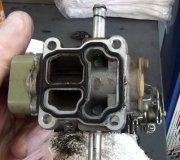Because the part you replaced wasn't the cause of the problem. It is not a sensor. It is a "stepper" motor idle speed control valve that is controlled by the Engine Computer. There's two possible causes for high or erratic idle speed. The most common is a vacuum leak the computer has no control over. The second is the computer is requesting the higher idle speed in response to something else. Most commonly that would be a problem with the intake air temperature sensor circuit or the coolant temperature sensor circuit.
If you have already checked the diagnostic fault codes, post those numbers in your reply. You can go here:
https://www.2carpros.com/trouble_codes/obd2/p0400
to see the definitions, or I can interpret them for you. Be aware no fault code ever says to replace a part or that one is bad. They only indicate the circuit or system that needs further diagnosis. When a part is referenced in a fault code, it is only the cause of that code about half of the time. First we have to rule out wiring and connector terminal problems, and things like that.
The fastest way to start this diagnosis is to use a scanner to view live data and see what "step" the computer has placed the idle speed motor to. The automatic idle speed motor which you replaced can be set to any of 256 "steps" or positions when the computer pulses its coils with varying voltages and polarities. As the step number increases, the armature rotates a threaded shaft that retracts the pintle valve on the end. As it does, it opens more of a controlled vacuum passage around the throttle blade. At the same time it increases the length of time the injectors are pulsed open to add more fuel. The increased air and fuel raises idle speed.
Step 32 is typical for a properly-running engine. With a single-cylinder misfire on a V-6 or V-8 engine, you can expect to see it around step 50. The secret now is look at the actual step number in relation to what the engine is doing. If you find it is at a real low step number, as in 5 to around 20, and idle speed is too high, the computer is trying to lower it, but without success. That points to a vacuum leak. If the step number is high along with high idle speed, the computer wants idle speed to be higher in response to some other sensor data. At that point you have to look at the readings from the other sensors to see if one doesn't make sense. For example, if the engine has been running for a while, the coolant temperature can't be 30 degrees. If the temperature is reported to be too low, the computer raises idle speed to aid in oil flow and faster warmup. Similarly, with an incorrectly-reported low intake air temperature, the computer will add more fuel to what it thinks is more-dense air.
All of this type of sensor have an acceptable range of signal voltage. Even though in this example of 30 degrees for coolant temperature, while that is seriously incorrect, it is a temperature within the acceptable range of that sensor, so the computer will likely not detect a problem or set a fault code for it. In this case it may set a different fault code for "running cold too long". That can also be set if the thermostat is stuck open or opening too soon.
If you don't have access to a scanner, start by pinching off various vacuum hoses to see if the idle speed will come down to normal. If it does, follow that hose, then pinch off hoses that branch off from it to narrow down the location of the leak.
Saturday, October 3rd, 2020 AT 2:03 PM



